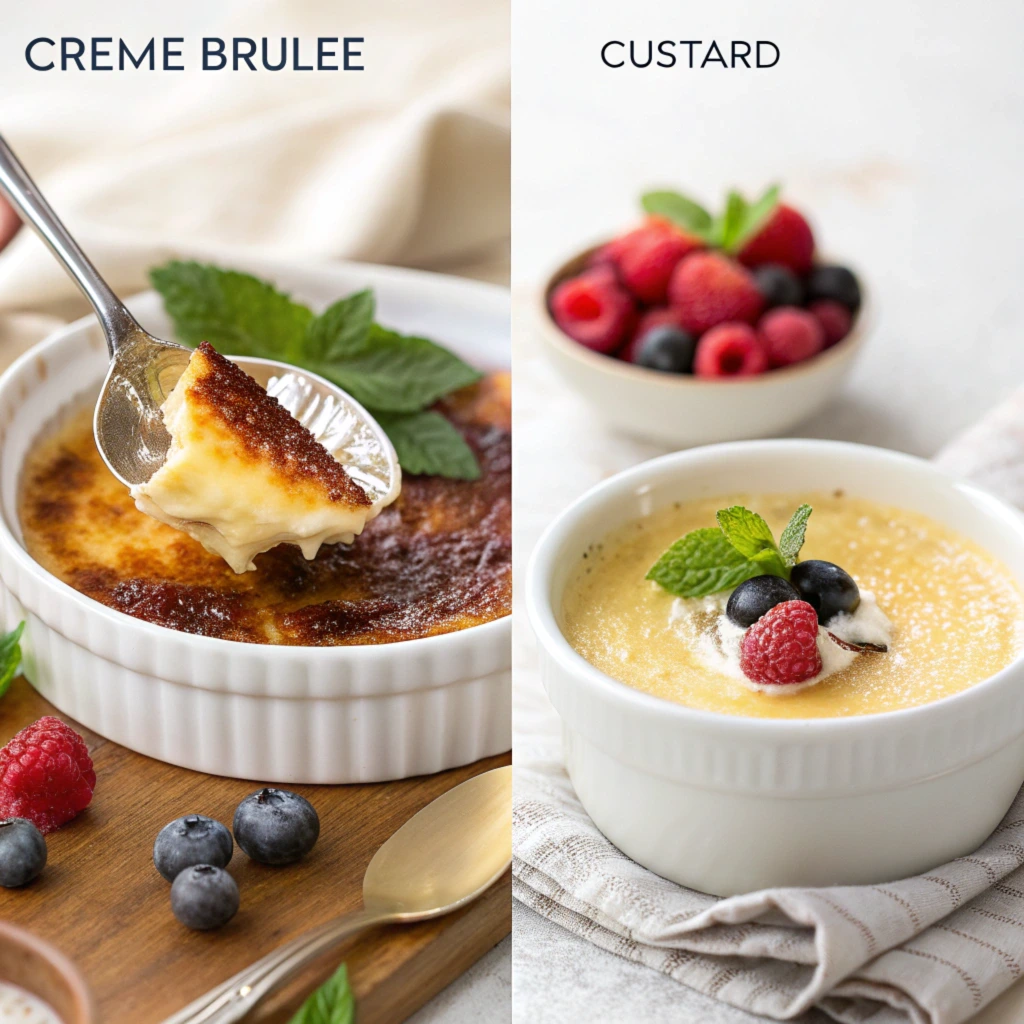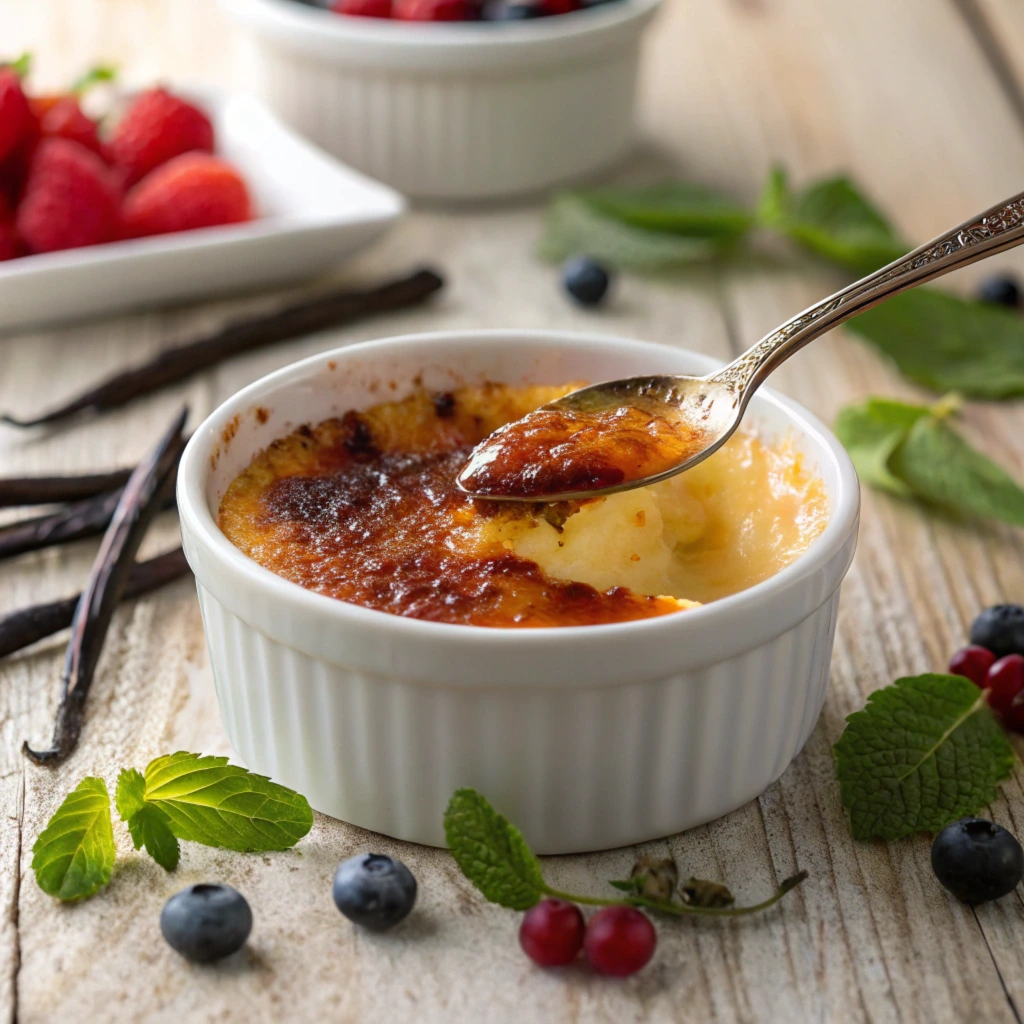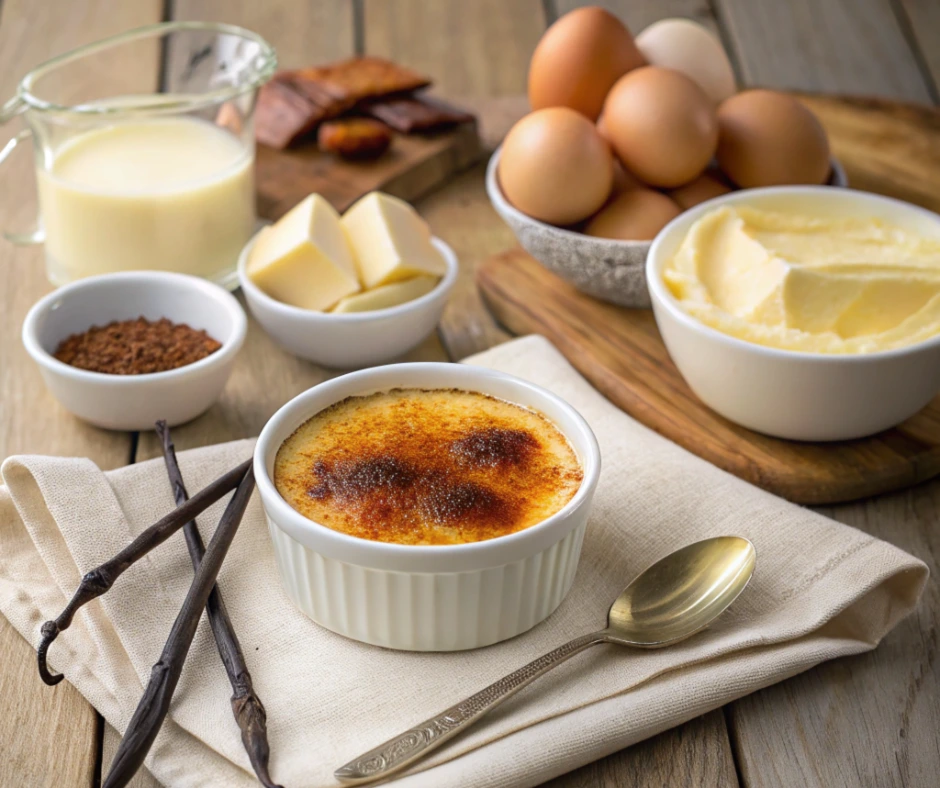Desserts like crème brûlée and custard often steal the spotlight at dinner tables, but what makes these creamy treats so special? And, more importantly, what sets them apart? While both share a rich, velvety texture and vanilla undertones, their preparation techniques, key ingredients, and presentation are distinct. This article dives deep into the nuances of these two iconic desserts, giving you a clear understanding of their differences, similarities, and the art behind their creation.
Introduction to Crème Brûlée and Custard
What Are Crème Brûlée and Custard?
Crème brûlée and custard are beloved desserts that boast a creamy, indulgent texture, often flavored with vanilla or other aromatic ingredients. Custard serves as the base for many classic desserts, including crème brûlée, crème caramel, and flan. Meanwhile, crème brûlée raises custard to new heights with its signature caramelized sugar crust.
Why Are These Desserts Often Confused?
The confusion lies in their shared foundation: a mixture of eggs, sugar, and dairy. Both are cooked to achieve a silky consistency, but their presentation and final touches make all the difference. While custard is versatile and used in pies, pastries, and as a dessert on its own, crème brûlée’s hallmark is its brittle, caramelized top layer, achieved with a blowtorch or broiler.
An Overview of Their Popularity in Dessert Culture
For centuries, custard-based desserts have been a cornerstone of culinary traditions worldwide. From French pâtisseries to American diners, crème brûlée and custard hold a special place in the hearts of dessert lovers. Their adaptability and elegance make them a favorite for home cooks and professional chefs alike.
Defining Custard
What Is Custard?
Custard is a smooth, creamy dessert made from a mixture of eggs, sugar, and dairy, gently cooked to achieve a rich and velvety texture. Known for its versatility, custard serves as the foundation for countless desserts, including pies, trifles, puddings, and pastries. Whether it’s baked to perfection, stirred to a glossy finish, or used as a filling, custard’s role in the culinary world is as essential as it is timeless.
Custard isn’t just a dessert, it’s a technique. By carefully balancing the cooking process, chefs and home cooks alike create this luxurious treat without curdling the eggs. The magic lies in its simplicity: a few basic ingredients transform into something truly indulgent with the right technique.
Key Ingredients in Custard
The basic ingredients of custard include eggs, dairy (milk or cream), and sugar. Variations can arise depending on the type of custard being prepared. For instance:
- Eggs: The primary thickening agent in custard. Using whole eggs yields a firmer texture, while egg yolks alone result in a silkier consistency.
- Dairy: Milk creates a lighter custard, while cream adds richness and decadence. Some recipes even mix both for a balanced texture.
- Sugar: Provides sweetness and helps stabilize the custard mixture during cooking.
- Flavorings: While vanilla is classic, modern custards may incorporate cocoa, coffee, fruit purees, or spices like cinnamon and nutmeg for added depth.
Each ingredient plays a vital role, and slight adjustments can create endless variations, making custard one of the most adaptable desserts.
Types of Custards: A Detailed Overview
Custards are broadly categorized into two main types, each with its unique characteristics and uses:
Baked Custards
Baked custards are set in the oven, often in a water bath to ensure even cooking. Examples include:
- Crème Caramel: A custard with a layer of caramel syrup that infuses the dessert as it cools.
- Flan: Similar to crème caramel, flan often includes cultural twists, like the addition of coconut or condensed milk in Latin American versions.
- Clafoutis: A French dessert that combines custard with baked fruits like cherries or plums.
Stirred Custards
Stirred custards are cooked on the stovetop and require constant whisking to prevent curdling. They remain pourable and are used as sauces or fillings:
- Crème Anglaise: A thin custard often poured over desserts.
- Pastry Cream: A thicker custard used in éclairs, tarts, and cream puffs.
- Pudding: While technically a custard, pudding has become synonymous with thicker, more homestyle desserts.
Custard Around the World
Custard’s versatility makes it a global favorite, with unique variations in different cultures. For example:
- In Britain, custard often accompanies warm desserts like sticky toffee pudding.
- In France, custards like crème brûlée and crème caramel are staples in fine dining.
- In Asia, custard buns and egg tarts showcase a lighter, less sweet take on this classic.
This adaptability has allowed custard to remain a dessert cornerstone for centuries.
Crème Brûlée as a Specialized Custard
What Makes Crème Brûlée Unique?
Crème brûlée is not just another custard, it’s an art form. What sets it apart is its distinct caramelized sugar crust, which adds a delightful crunch to the silky-smooth custard underneath. The process of torching sugar on top creates a contrast of textures and flavors that has made this dessert iconic.
Key Ingredients in Crème Brûlée
The ingredients in crème brûlée are similar to custard but with a slightly richer twist. Heavy cream is the primary dairy component, lending a luxurious texture. Egg yolks provide structure, while sugar and vanilla create a balance of sweetness and flavor. The magic happens when granulated sugar is sprinkled on top and caramelized into a crisp shell.
The Role of the Sugar Crust in Crème Brûlée
The sugar crust is the pièce de résistance of crème brûlée. It’s not just about taste, it’s about the experience. Breaking through the hard, glassy surface with a spoon reveals the creamy custard beneath. This contrast makes crème brûlée stand out as a dessert that’s both simple and sophisticated.
How Crème Brûlée Differs from Other Custards in Texture and Taste
While crème brûlée is technically a custard, its preparation and presentation set it apart. It’s baked in individual ramekins and served directly, ensuring each portion has its own perfect sugar crust. In contrast, many custards are used as fillings or bases for other desserts. The addition of the caramelized topping gives crème brûlée a flavor depth and textural complexity that custard on its own simply cannot match.
A Side-by-Side Comparison: Crème Brûlée vs. Custard

Differences in Ingredients
While both desserts share foundational ingredients like eggs, sugar, and dairy, the proportions and types of dairy create their distinct differences. Chefs often prepare custard with milk, cream, or a mixture, resulting in a lighter consistency in some variations. Crème brûlée, by contrast, uses only heavy cream to deliver its luxurious richness. Additionally, crème brûlée frequently relies on vanilla for its simple yet indulgent flavor, whereas custard offers more variety with flavors like chocolate, coffee, or fruit.
Differences in Preparation Techniques
Preparation significantly distinguishes these desserts. Chefs often bake custard in a water bath for stability or stir it continuously over low heat to prevent curdling. Crème brûlée demands a precise baking process to preserve its creamy texture, and its highlight comes when chefs torch the sugar topping to create its characteristic caramelized crust. This step enhances the texture and adds a burst of flavor that traditional custards do not offer.
Key Flavor Profiles and Variations
The flavor profile of custard varies widely, depending on the ingredients and preparation method. It can be light and delicate or dense and rich. Crème brûlée, however, is unmistakably indulgent, with a silky texture balanced by the toasty sweetness of its caramelized sugar topping. This distinction makes crème brûlée a showstopper at any meal.
Pro Tip: For a detailed guide on achieving the perfect caramelized sugar topping, check out What is the Secret to Crème Brûlée?.
Similar Desserts That Create Confusion
Flan and Its Relationship to Custards
Although many mistake flan for crème brûlée, it offers a distinct appeal as another custard-based dessert. Chefs pour its caramel syrup topping into the bottom of the mold, allowing it to become the highlight when they invert the dessert for serving. Unlike crème brûlée, flan lacks a hardened sugar crust, resulting in a softer and more uniform texture.
Crème Caramel: Another Custard Variant
Crème caramel is similar to flan but leans towards a lighter custard consistency. Its defining feature is the layer of caramel that soaks into the custard as it cools, creating a balance of sweetness throughout. While crème brûlée focuses on contrasting textures, crème caramel highlights its harmonious melding of flavors.
How Crème Brûlée Stands Out
What separates crème brûlée from these custard cousins is its preparation and presentation. Served directly in individual ramekins with its signature caramelized sugar crust, crème brûlée exudes sophistication. It’s not just a dessert; it’s an experience.
For more indulgent custard-based recipes, check out the article How to Make Crab Brûlée Recipe.

Common Questions About Crème Brûlée and Custard
Is Crème Brûlée a Type of Custard?
Yes, crème brûlée is a custard at its core, but it comes with a twist! The caramelized sugar crust defines its unique crunch. Chefs create its creamy custard base with a higher ratio of cream to milk, which produces a richer texture compared to traditional custards. This distinction often prompts the question: is all custard crème brûlée? The answer is no. While crème brûlée belongs to the custard family, not all custards include the iconic sugar topping that distinguishes crème brûlée.
What Are the Health Considerations of Each?
Both crème brûlée and custard offer indulgent flavors and are best enjoyed in moderation. The higher amounts of cream and sugar make crème brûlée richer in calories and fat. Custards vary in their nutritional profile based on the ingredients, with lighter versions often substituting milk for cream. For a slightly healthier option, consider choosing a simple baked custard. As occasional treats, however, both desserts satisfy the cravings of dessert lovers.
Which Dessert Is Easier to Make at Home?
Custard is more beginner-friendly because its preparation methods offer greater flexibility. Bakers can bake, stir, or even steam it without needing specialized tools. On the other hand, crème brûlée, though straightforward, demands precision to create the perfect caramelized sugar crust. Most chefs prefer a kitchen torch for this step, but a broiler works as an alternative.
What’s the Nutritional Difference Between Crème Brûlée and Custard?
The fat content is the main nutritional difference between these desserts. Heavy cream and the sugar topping increase the calories and fat in crème brûlée, while custard often uses milk to create a lighter option. Both desserts include a significant amount of sugar, so enjoy them as occasional treats.
Can You Substitute Crème Brûlée for Custard in Recipes?
While crème brûlée is a type of custard, its distinct sugar crust may not suit all recipes calling for custard. For instance, in tarts or pies, a classic custard without the hardened topping might work better.
Is Flan Closer to Crème Brûlée or Custard?
Flan is closer to custard because it lacks the caramelized crust of crème brûlée. Its caramel syrup creates a softer, more uniform texture throughout the dessert.
How Do You Make the Perfect Crème Brûlée or Custard?
Achieving perfection in either dessert requires attention to detail. For crème brûlée, focus on evenly caramelizing the sugar topping. For custard, mastering the art of slow cooking ensures a silky, lump-free texture.
Conclusion and Expert Tips
Summarizing the Key Differences
Crème brûlée and custard may share a common foundation, but their differences make each dessert special. While both rely on a mixture of eggs, sugar, and dairy for their creamy texture, the signature caramelized sugar crust gives crème brûlée its unique appeal. Custard, on the other hand, showcases its versatility and adaptability in a variety of desserts or as a standalone treat.
Tips for Choosing the Right Dessert for Your Occasion
Choosing between these two treats depends on the occasion. Crème brûlée is ideal for a sophisticated dinner or when you want to impress your guests with its crunchy sugar topping. Custard, being simpler and more versatile, works well for casual settings or as a base for other desserts like pies and trifles.
Encouragement to Explore and Experiment
Why settle for just one? Experiment with both desserts in your kitchen to discover their unique charm. By mastering the basics of custard, you’ll also unlock the secret to making perfect crème brûlée, an impressive skill for any home chef. Happy cooking!

